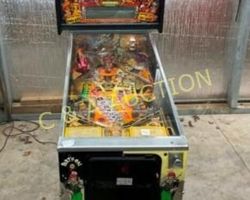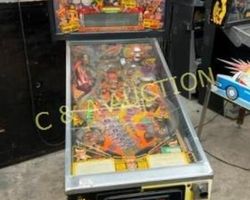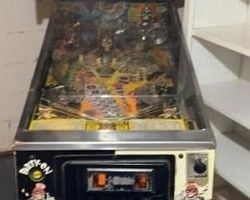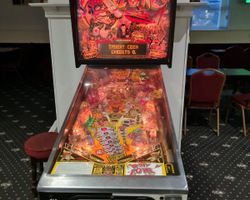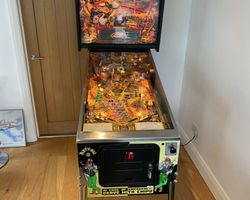Party Zone
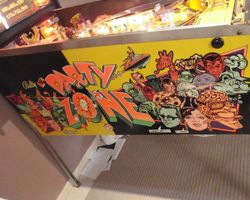
Average Prices: USD $600 to $1,900
Produced: August, 1991
Machine Type: Solid State Electronic
MPU: Williams WPC (Dot Matrix)
Players: 4
Design by: Dennis Nordman
Art by: Greg Freres
Dots/Animation by: Scott Slomiany
Mechanics by: Win Schilling, Zofia Bil
Music by: Dan Forden
Sound by: Dan Forden
Software by: Jim Strompolis
Bally Manufacturing Co. launched Party Zone in September 1991, an energetic pinball machine designed to encapsulate a vibrant, celebratory atmosphere. Emerging from the Williams WPC (Dot Matrix) generation, this solid-state electronic game was conceived by Dennis Nordman, with artwork brought to life by Greg Freres. The collaborative effort extended to the sound and music, handled by Dan Forden, and software development by Jim Strompolis. Voice-over talents, including John Keeney as the voice of Captain B. Zarr, further defined the machine’s auditory character. With approximately 3,862 units produced, Party Zone entered a competitive market during a pivotal era for pinball, offering a distinct and lighthearted experience.
A unique aspect of Party Zone's thematic foundation lies in its playful amalgamation of characters from earlier Bally and Midway titles. The Party Animals from Bally Midway's 1987 Party Animal, the Party Monsters from Midway's 1989 Elvira and the Party Monsters, and the Party Dudes from Midway's 1990 Dr. Dude And His Excellent Ray all converge at the Cosmic Cottage on the playfield. This narrative thread creates a shared universe, inviting players into a familiar yet fresh celebration. The central marketing slogan, "You are now entering: The Party Zone," perfectly framed the machine's intent: to transport players directly into a lively, music-filled event.
Signature Features and Design
Party Zone stands out for its array of interactive toys and visual flair, all contributing to its overarching theme. Dominating the upper playfield is Captain B. Zarr, an animated head that dynamically turns to follow the pinball, lending a sense of being an active participant in the party. Below, the Dancing Dummy, a crash-test figure, adds kinetic energy, while the Supersonic Robotic Comic provides another engaging character. A physical Rocket toy on the playfield integrates directly into a key ramp shot, enhancing both visual appeal and gameplay flow. The Cosmic Cottage, a miniature structure, serves as a crucial target for initiating multiball.
The machine features clear, curving ramps that are both visually appealing and define much of the playfield's ball flow. These transparent structures offer players an unobstructed view of the ball's journey, adding to the excitement. A standout feature is the player's ability to select music when prompted, allowing a degree of personalization to the gameplay experience. Furthermore, achieving the "Big Bang" feature triggers a full playfield illumination pulse in red, accompanied by a resonant 'sonic boom' sound effect, creating an impactful visual and auditory climax that reinforces the game's high-energy theme. These integrated design elements combine to create a cohesive and captivating pinball experience, making the playfield a dynamic, living environment.
Playfield and Mechanics
The Party Zone playfield is thoughtfully designed to encourage continuous action and reward diverse shots. At its base, two flippers control the ball, flanked by two slingshots. Three spring-mounted bumpers, colloquially known as "Boppers," are strategically placed to keep the ball in motion and build scores. The layout includes two inlanes and two outlanes, providing traditional ball return and drainage opportunities. The main ramp, often referred to as the Rocket Ramp, is a primary target, integral to various scoring sequences and objectives.
Multiple target banks are distributed across the playfield: three HA-HA-HA targets, five Eat, Drink & Be Merry targets, and four Way Out Of Control targets. An Advance EZB (End Zone Bonus) target and two Request Targets near the Captain B. Zarr saucer complete the array of static targets. Interactive saucers include the Comic Saucer and the Captain B. Zarr (CB) Saucer, which serve as collection points and trigger specific modes. Key lanes—Cottage Entry, Comic Entry, B-O-P (three rollover lanes), Door, and Back-2-Bop—guide the ball through different scoring opportunities and mode progressions.
The artwork by Greg Freres blankets the playfield in a vibrant, quirky, and distinctly 90s aesthetic. The color scheme is bright and eye-catching, complementing the animated elements. Lighting plays a significant role in the overall presentation, with highly praised strobing and color-changing effects that accentuate gameplay moments. The Dot Matrix display, visible through the backglass, enhances player immersion by showcasing dynamic animations and guiding players through game objectives, seamlessly blending visual information with the frantic pace of play. The design philosophy emphasizes a flow that feels smooth and enjoyable, with ramp shots forming the backbone of many sequences, drawing players deeper into the machine's festive world.
Gameplay Dynamics
Party Zone's gameplay mechanics are structured around a series of interconnected objectives designed to maintain high energy and encourage varied shots. The game begins with a "Door Prize" skill shot, awarded by plunging the ball through the door for incremental millions. The "End Zone Bonus" offers points when the ball drains through the outlanes, a value that players can increase by hitting the Advance End Zone Bonus target.
One distinctive element is "Request Time," lit at the game's start or by hitting two targets. Landing the ball in the DJ Eject during this time awards points and presents a choice of music from a selection of four tracks. This feature not only adds an auditory dimension but can also trigger a "Party Saver" award. Completing the B-O-P rollover lanes advances the "Bonus Booster," and once maxed, further completions award a "Bop Bonus." Hitting Back-2-Bop lights the "Dance Contest," transforming the bumpers into high-scoring targets.
The "Eat, Drink & Be Merry" sequence progresses by hitting five targets ("Eat"), then the ramp ("Drink" at the Comic eject), and finally the Comic Saucer within a time limit ("B. Merry") before hitting the CB Saucer for a significant point award. The "Way Out of Control" (W-O-O-C) targets, when completed, light a payoff lane for awards like 5 Million, Boppers for 1 Million per bop, 10X Playfield values, or a Special. The Rocket Ramp itself is crucial, awarding "Ozone Bonus," extra balls after a sequence of shots, and further points if "Eat" is lit.
The "Supersonic Robotic Comic" is lit by completing the HA-HA-HA targets and can award a "Laff Attack" frenzy mode, where all targets score 100K points. The game’s main draw is the "Happy Hour" Multiball, initiated by locking three balls into the Cosmic Cottage or as a "Surprise" award from the Comic. During multiball, the primary objective is to shoot the Rocket Ramp for jackpots, which range from 1 to 7 million based on the "Rocket Fuel" value. Players increase Rocket Fuel by hitting the Comic or Back-2-Bop. Once enough fuel is collected, the "Big Bang" jackpot is lit at the ramp, awarding 10 million for the first shot and a variable, potentially massive, value for the second. A memorable detail is the playing of Jimi Hendrix's "Purple Haze" when the big jackpot is attained during multiball. If one ball drains, 2X Playfield scoring is activated for the remaining ball, providing a last-ditch opportunity for high scores. Strategic play often involves focusing on the Cosmic Cottage for multiball, followed by consistent Rocket Ramp shots, and utilizing the Way Out of Control targets to activate the 10X Playfield multiplier.
Reception and Legacy
Party Zone largely garnered a positive reception within the pinball community, praised for its immediate fun and inviting gameplay. Many players found the machine highly engaging, citing a strong "one more game" appeal. The quirky, colorful, and distinctly 90s theme, along with Greg Freres' artwork, was frequently highlighted as memorable and charming, even by those who initially found its goofy aesthetic unconventional. The vibrant color scheme, dynamic lighting, and detailed playfield were consistently lauded for their visual appeal.
A significant strength identified by players is the machine's accessibility. Party Zone is often considered an enjoyable experience for a wide range of skill levels, from casual players to novices, making it a gateway pinball machine for many. The interactive toys, particularly Captain B. Zarr's animated head and the dancing dummy, contribute significantly to the machine's unique character and appeal, enhancing the overall playful atmosphere. The ramp shots and overall playfield layout were also well-regarded, contributing to a smooth and fluid gameplay experience. Enthusiasts appreciated the energetic music and distinct DJ callouts, with the option to select songs adding a personalized touch, despite some acknowledging that the audio quality felt dated over time. The dynamic lighting, including strobing and color-changing effects, further enhanced key gameplay moments.
However, Party Zone was not without its criticisms. Some experienced players noted a relatively shallow ruleset, suggesting it might not satisfy those seeking deeply complex or strategic gameplay. This simplicity could lead to repetitive shots and a feeling that the gameplay might lose its excitement over extended periods. The Captain B. Zarr shot was occasionally described as a "suicide shot" due to its tendency to lead to immediate drains, and some players observed issues with ball flow and pacing. While the artwork was generally well-received, a minority found it childish or unattractive. A few critics also pointed out that the game's relative lack of depth might deter collectors looking for a machine with long-term strategic appeal for a private collection.
Despite these minor criticisms, Party Zone maintains a reputation as a genuinely fun and charismatic pinball machine. Its enduring legacy is rooted in its ability to deliver an immediate, enjoyable, and high-energy experience. As a product of the Williams WPC era, it exemplifies the period's embrace of animated playfield toys and humorous themes. Its success demonstrated the appeal of integrated character universes, bringing together figures from previous Bally titles to create a cohesive party atmosphere. Party Zone’s blend of approachable gameplay, distinctive theme, and interactive elements solidified its place as a cherished game that continues to entertain players looking for an unadulterated, lively pinball experience.
Sponsored Links
 Ebay Listings
Ebay Listings
 Auction Results
Auction Results
| Cost | Location | Date |
|---|---|---|
| USD $860 |  Indiana, United States Indiana, United States |
17 December, 2024 |
| USD $3,500 |  California, United States California, United States |
16 August, 2023 |
| GBP £2,200 |  United Kingdom United Kingdom |
24 June, 2023 |
| USD $2,100 |  Virginia, United States Virginia, United States |
03 June, 2023 |
| USD $1,600 |  Virginia, United States Virginia, United States |
03 June, 2023 |
| USD $6,500 |  Connecticut, United States Connecticut, United States |
10 May, 2023 |
| USD $4,500 |  California, United States California, United States |
16 December, 2022 |
| GBP £2,250 |  United Kingdom United Kingdom |
23 October, 2022 |
| USD $3,100 |  Minnesota, United States Minnesota, United States |
09 August, 2022 |
| GBP £4,500 |  Yeldham, United Kingdom Yeldham, United Kingdom |
23 April, 2022 |


Private Policy · Search Website · Contact Us
As an eBay Partner, we may earn a commission from qualifying purchases made through links on this site, at no additional cost to you.
All trademarks and copyrighted materials remain property of their respective owners. All other content copyright 2007 - 2025 Pinpedia.

